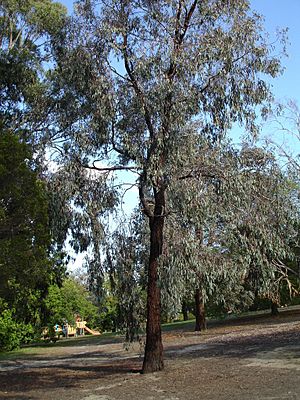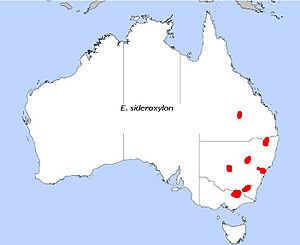Mugga ironbark facts for kids
Quick facts for kids Mugga ironbark, red ironbark |
|
|---|---|
 |
|
| Scientific classification | |
| Genus: |
Eucalyptus
|
| Species: |
sideroxylon
|
 |
|
| E. sideroxylon, field distribution | |
The Mugga Ironbark (scientific name: Eucalyptus sideroxylon) is a special tree found only in eastern Australia. It's also called the Red Ironbark. This tree is known for its dark, rough bark that looks like iron. It has long, narrow leaves, and its flowers can be white, red, pink, or creamy yellow. After flowering, it grows small, round fruits.
Contents
What the Mugga Ironbark Looks Like
The Mugga Ironbark is a medium-sized tree, usually growing about 25 to 35 meters (82 to 115 feet) tall. Its bark is very easy to spot! It's dark grey to black and has deep grooves, making it look like tough, old iron. This bark covers the main trunk and bigger branches. The smaller, thinner branches have smoother, lighter bark that can be white or grey.
Young Mugga Ironbark trees and new shoots have long, narrow leaves, about 3 to 11 centimeters (1.2 to 4.3 inches) long. As the tree gets older, its leaves become lance-shaped, meaning they are wider in the middle and taper to a point. These adult leaves are green on both sides and measure about 5 to 14 centimeters (2 to 5.5 inches) long.
Flowers and Fruit
The flowers of the Mugga Ironbark grow in groups of seven. Each group is on a stalk that can be up to 2.9 centimeters (1.1 inches) long. The flower buds are oval or diamond-shaped.
Mugga Ironbark trees can flower for a long time, from April all the way to December. Their flowers come in many colors: white, red, pink, or creamy yellow. After the flowers bloom, they turn into woody, cup-shaped fruits. These fruits are about 5 to 11 millimeters (0.2 to 0.4 inches) long and wide.
Naming the Mugga Ironbark
The scientific name Eucalyptus sideroxylon was first recorded by a botanist named Allan Cunningham in 1848. Later, in 1887, William Woolls officially described the species.
The name sideroxylon comes from two ancient Greek words:
- sidēros (σίδηρος) means "iron"
- xylon (ξύλον) means "wood"
This name perfectly describes the tree's hard, iron-like wood and bark!
There are two main types, or subspecies, of Mugga Ironbark:
- Eucalyptus sideroxylon subsp. improcera: This type is a smaller, more stunted tree with shorter, wider leaves and longer flower buds.
- Eucalyptus sideroxylon subsp. sideroxylon: This is the more common type described above.
Where Mugga Ironbark Grows
The Mugga Ironbark is very common and grows widely across eastern Australia. You can find it in woodlands from southeastern Queensland, through New South Wales, and down into Victoria.
The subspecies improcera is found in a specific area called the Barakula State Forest, which is north-northwest of a town called Chinchilla in Queensland.
How People Use Mugga Ironbark
The wood of the Mugga Ironbark is very hard and heavy. It's so dense that it's one of the few types of wood that won't float in water! Because it's so strong and resists rotting, it's used for many things:
- Firewood: It burns well because it's so dense.
- Construction: It's used for fence posts, piers (like parts of a dock), and railway sleepers (the wooden beams under train tracks).
- Furniture: The heartwood (the inner part of the tree) is dark red, and the sapwood (the outer part) is pale yellow. It's hard to work with, but it can be polished to a beautiful shine. In the past, it was popular for making furniture and turned items.
Other Uses
The leaves of the Mugga Ironbark are used to make cineole-based eucalyptus oil. This oil is known for its strong, fresh smell and is used in many products.
Beekeepers in New South Wales often place their beehives in areas where Mugga Ironbark trees grow. This is because the trees produce a lot of nectar, which the bees collect to make delicious honey.
Growing Mugga Ironbark
Mugga Ironbark trees are quite easy to grow from seeds. They are very tough and can survive in places that get less than 400 millimeters (16 inches) of rain each year. However, they can also grow well in areas with much more rain, over 1000 millimeters (39 inches) per year. This makes them very adaptable trees.
Images for kids
See also
 In Spanish: Mugga para niños
In Spanish: Mugga para niños





